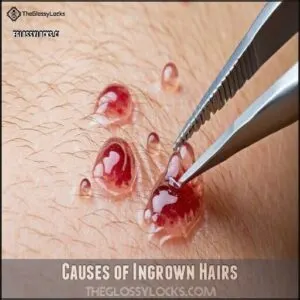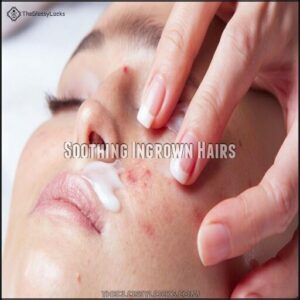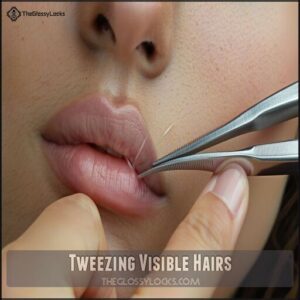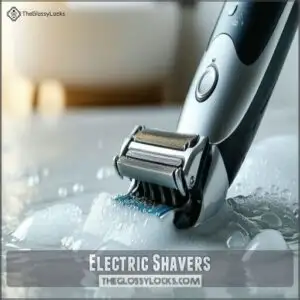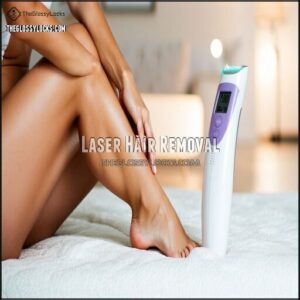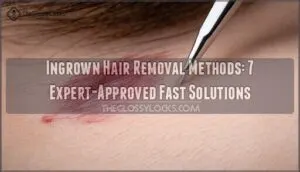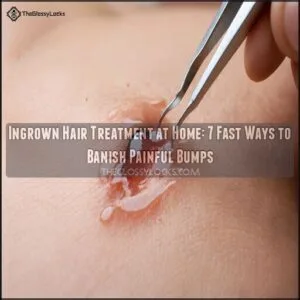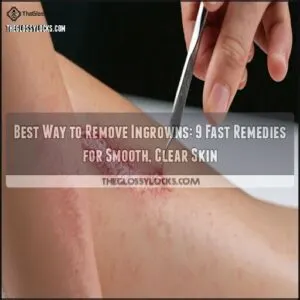This site is supported by our readers. We may earn a commission, at no cost to you, if you purchase through links.
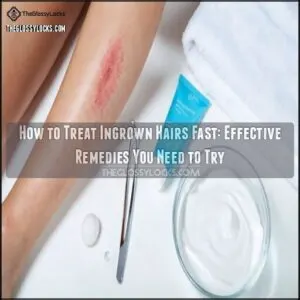
Apply a warm compress for 10-15 minutes to soften the skin and open up your pores—it’s like giving those stubborn hairs an escape route. Gently exfoliate with a scrub or a washcloth to remove dead skin, but don’t go overboard; less is more here.
If the hair’s visible, you can carefully tease it out with clean tweezers. For irritation, use hydrocortisone cream to calm redness.
Remember, patience is key—rushing can make it worse! Stay tuned for simple tips ahead, and keep in mind that prevention is crucial.
Table Of Contents
- Key Takeaways
- Causes of Ingrown Hairs
- Treating Ingrown Hairs Fast
- Preventing Ingrown Hairs
- Soothing Ingrown Hairs
- Removing Ingrown Hairs
- Home Remedies for Ingrown Hairs
- Frequently Asked Questions (FAQs)
- How do you get rid of ingrown hairs asap?
- What draws out ingrown hairs?
- How to soothe ingrown hairs overnight?
- Can stress or hormonal changes cause ingrown hairs?
- Do dietary habits impact the likelihood of ingrown hairs?
- Can certain medications increase the risk of ingrown hairs?
- Are there specific fabrics that reduce ingrown hair risk?
- What role does hydration play in preventing ingrown hairs?
- Conclusion
Key Takeaways
- Stop shaving the affected area and use a warm compress to open pores and soften your skin, helping trapped hairs emerge.
- Gently exfoliate with a scrub or chemical exfoliant like salicylic acid to remove dead skin and free ingrown hairs.
- Use sterilized tweezers to carefully lift visible ingrown hairs, but avoid forcing them out to prevent infection or scarring.
- Apply hydrocortisone cream for irritation and redness, but avoid overusing and keep the area clean to ensure proper healing.
Causes of Ingrown Hairs
Ingrown hairs happen when hair grows back into the skin instead of up and out, often causing irritation.
Shaving, waxing, tight clothing, and certain hair types can all increase the risk, making prevention key.
Hair Removal Methods
Hair removal methods like shaving, waxing, and tweezing can easily trigger ingrown hairs if not done right.
Shaving techniques that use dull razor blades or go against the grain often create sharp edges, leading to irritation.
Using dull razor blades or shaving against the grain can create sharp edges, causing irritation and increasing the risk of ingrown hairs.
Waxing techniques and depilatory creams can disrupt hair growth, while sugaring benefits softer skin.
Threading precision and epilator effectiveness help minimize risks, but results vary.
Curly Hair Types
Curly hair grows in loops and spirals due to its unique follicle shape and curl patterns.
This makes it more likely to bend back into the skin, leading to higher ingrown severity.
Growth direction often changes, causing skin inflammation.
Regular exfoliation helps prevent blockages, while proper ingrown hair treatment and gentle ingrown hair removal techniques keep irritation under control for smoother results.
Friction From Clothing
Tight clothing can trap sweat and increase friction, irritating your skin and causing ingrown hairs.
Opt for loose, breathable fabrics to reduce rubbing and improve air circulation. After workouts, always change into dry clothes to prevent skin irritation.
Prioritize soft, natural fibers to minimize sensitivity. Reducing friction with the right clothing is an easy way to prevent ingrown hairs effectively.
Consider gentle exfoliation methods to further reduce ingrown hairs, using techniques that promote gentle care and prevent skin irritation.
Shaving Techniques
Friction from clothing isn’t the only culprit—your shaving technique plays a big role in how to treat ingrown hairs fast.
Follow these tips:
- Use a razor with fewer blades to minimize razor burn.
- Shave in the hair’s growth direction to prevent irritation.
- Avoid pulling skin taut, which traps hair.
- Practice proper razor maintenance to avoid dull blades.
Treating Ingrown Hairs Fast
When dealing with ingrown hairs, quick action brings fast relief.
Start by gently exfoliating the area to free trapped hairs—chemical exfoliants like salicylic or glycolic acid are great for this. A warm compress works wonders, softening the skin and making it easier for the hair to emerge.
Gently exfoliate with salicylic acid and use a warm compress to soothe skin and free trapped hairs effortlessly.
To manage pain or redness, a touch of hydrocortisone cream can help, but don’t overuse it. If the hair is visible, sterilized tweezers can gently remove it—be careful to prevent scarring or infection.
For persistent cases, options like over-the-counter retinoids or dermatologist treatments can speed up healing. No matter the method, keeping the area clean and using antibiotic ointments guarantees proper healing.
You’re closer to smooth, irritation-free skin!
Preventing Ingrown Hairs
Preventing ingrown hairs starts with simple habits like exfoliating your skin regularly and switching to gentler hair removal methods.
By making small adjustments, like shaving in the direction of hair growth and wearing loose clothes, you can substantially reduce your risk of getting ingrown hairs with gentler methods.
Exfoliation Methods
Exfoliation is the secret sauce for keeping ingrown hairs in check. A consistent routine smooths your skin and boosts hair growth in the right direction.
Here’s how to start:
- Use physical exfoliation tools like a loofah or scrub gloves.
- Stick to exfoliating 2-3 times weekly to avoid irritation.
- Gently buff sensitive skin areas.
- Try products suited for your skin type.
For enhanced skincare, consider loofah for exfoliation. This approach will help you maintain healthy skin.
Chemical Exfoliants
Chemical exfoliants like salicylic acid, glycolic acid, and lactic acid can work wonders for freeing trapped hairs.
Products such as serums or toner pads are great for sensitive skin, helping dissolve dead cells without harsh scrubbing. You can find a suitable chemical exfoliant serum for your skin type.
Balance your exfoliation frequency—too much might risk a chemical burn. Look for AHA vs. BHA skin exfoliating products to maintain smooth, irritation-free skin, and consider the importance of smooth skin.
Shaving Tips
Shaving smartly can prevent irritating ingrown hairs.
Here are essential shaving tips:
- Use a sharp blade and replace it regularly to avoid dullness and razor rash.
- Always shave in the direction of hair growth to reduce irritation.
- Prep your skin with warm water and shave gel to minimize friction.
- Avoid shaving daily; give your skin time to recover.
Wearing Loose Clothing
Tight clothes can turn your skin into a battleground of redness and irritation. Opt for loose-fitting options, especially after treating ingrown hairs.
Nighttime wear should be breathable to reduce skin inflammation. Prioritize exercise clothing made from moisture-wicking fabric to prevent flare-ups.
Here’s a quick comparison:
| Scenario | Tight Clothes Impact | Loose Clothes Benefit |
|---|---|---|
| Daily Wear | Skin redness, ingrown hairs | Post-treatment comfort |
| Exercise Clothing | Trapped sweat, irritation | Less skin inflammation |
| Nighttime Wear | Skin rubbing, irritation | Breathable fabric choice |
The table highlights the benefits of choosing the right clothing to prevent skin issues, emphasizing the importance of loose-fitting options and breathable fabric for overall skin health.
Soothing Ingrown Hairs
When an ingrown hair starts acting up, knowing how to soothe it quickly can save you from discomfort. Simple remedies like compresses and creams help reduce redness and calm irritation.
Cold Compresses
When soothing ingrown hairs, a cold compress works wonders for immediate relief.
It helps with redness reduction and inflammation control by calming irritated skin.
Apply it for 10-15 minutes—this compress duration is ideal.
Repeat the application frequency a few times daily for quick ingrown hair relief.
Don’t forget post-treatment care to keep your skin happy and inflammation-free.
Hydrocortisone Cream
If redness and inflammation from ingrown hairs are driving you crazy, hydrocortisone cream can help.
A 1% strength steroid cream calms irritation and reduces swelling fast.
Apply sparingly no more than twice daily to avoid side effects like skin thinning.
Long-term use isn’t recommended, so consider alternative treatments if needed.
Always keep the area clean for best results.
Warm Compresses
A warm compress works wonders for ingrown hairs by softening the skin and encouraging stubborn hairs to emerge.
Keep it cozy—not scorching—and apply 10-15 minutes a few times daily.
Use clean cotton cloths or compress materials soaked in warm water, and enhance results with added solutions like tea tree oil for inflammation reduction.
This simple ingrown hair home remedy is skin care bliss, and using it can lead to significant inflammation reduction.
Antibiotic Ointments
After using warm compresses, consider an antibiotic ointment for an infected ingrown hair.
It helps fight bacteria, reducing the chance of a skin infection or worsening pustules. Apply a thin layer gently, avoiding overuse to prevent resistance concerns or side effects.
If infection persists, explore alternative treatments like dermatologist-recommended options. Preventative use can keep future issues away.
Regular exfoliation prevents clogged follicles is a key step in maintaining healthy skin and preventing ingrown hair issues, and by following these steps, you can reduce the risk of skin infection.
Removing Ingrown Hairs
Removing ingrown hairs requires careful attention to avoid irritation and infection.
Whether you’re using tweezers, an electric shaver, or considering laser removal, it’s all about choosing the safest method for your skin.
Tweezing Visible Hairs
If warm compresses didn’t help, tweezing visible hairs might be your next step.
Always prioritize tweezing precautions—start with tool sterilization to avoid infection. Use a sterilized needle to gently lift the ingrown hair before tweezing.
Avoid forcing it out to reduce scarring risks. Many people find success using specialized ingrown tweezers.
By handling ingrown hair extraction carefully, you’ll encourage proper hair regrowth without further irritation.
Electric Shavers
Switching to an electric shaver can reduce ingrown hairs by offering gentler hair removal. Foil shavers suit sensitive skin, while rotary models adapt to contours.
Cordless options add flexibility, though corded shavers guarantee consistent power.
Regular cleaning prevents irritation and prolongs use. Sharp blades are essential for a close shave.
Unlike traditional razors, electric shavers minimize sharp edges, making it easier to prevent ingrown hairs while shaving comfortably. Sharp blades are a key factor in this process.
Laser Hair Removal
Tired of battling stubborn ingrown hairs with electric shavers? Laser hair removal offers a permanent hair solution by targeting hair follicles directly.
Here’s what to know about this long-term option:
- Laser cost varies but saves money over time.
- Treatment duration includes multiple sessions for smooth results.
- Suitable for most skin types, though some risks like dyspigmentation exist.
Home Remedies for Ingrown Hairs
You can tackle pesky ingrown hairs at home with simple, natural ingredients that ease inflammation and soothe your skin.
These remedies are easy to prepare and can help your skin recover quickly while preventing further irritation, which is a complete concept to consider for natural remedies.
Yogurt and Oatmeal Mix
Did you know yogurt and oatmeal can soothe ingrown hairs while brightening your skin?
Packed with probiotic benefits and lactic acid, this mix reduces inflammation and exfoliates gently.
To prepare, combine 1/3 cup yogurt with 2 tablespoons oatmeal, apply for 2-3 minutes, then rinse off.
It’s simple, effective, and skin-friendly.
| Ingredient | Benefit | Application Duration |
|---|---|---|
| Yogurt | Probiotic benefits, lactic acid | 2-3 minutes |
| Oatmeal | Skin exfoliation, soothes redness | 2-3 minutes |
| Final Mix | Reduces irritation | 2-3 minutes |
This mix is easy to prepare and provides gentle exfoliation, making it a great addition to your skincare routine.
Aspirin-Honey Treatment
The aspirin-honey treatment is a powerhouse for soothing ingrown hairs.
Aspirin’s benefits reduce inflammation while honey’s properties fight bacteria.
For this remedy, mix:
- 3 aspirin tablets (crushed)
- 1 tsp honey
- 1/2-1 tsp water or oil
Apply gently, leave for 10 minutes, then rinse.
Repeat twice weekly to calm sensitive skin and prevent irritation.
Tea Tree Oil Soak
Tea tree oil is a powerhouse for ingrown hair remedies, thanks to its anti-inflammatory, antibacterial properties.
For an effective soak, dilute 4-5 drops in warm water, ensuring safe use for sensitive skin.
Soak the affected area for 10-15 minutes, as needed, this ingrown hair treatment option reduces redness, soothes irritation, and accelerates healing.
Remember, moderation is key for TTO benefits!
Aloe Vera-Baking Soda Treatment
Aloe vera and baking soda team up as a powerhouse for ingrown hair remedies.
Aloe vera’s anti-inflammatory properties soothe irritated skin, while baking soda benefits exfoliate gently, promoting healing.
For treatment application, mix two tablespoons of aloe vera with one tablespoon of baking soda. Apply to sensitive areas, leave for 2-3 minutes, then rinse.
Aloe vera can also improve scalp health, reducing irritation, and this alternative remedy calms and softens effectively.
Frequently Asked Questions (FAQs)
How do you get rid of ingrown hairs asap?
Imagine a stubborn guest overstaying their welcome—start with a warm compress to open pores.
Then exfoliate gently, apply salicylic acid to reduce inflammation, and moisturize.
Quick and careful focus speeds up healing without irritation, which is crucial for a smooth recovery.
What draws out ingrown hairs?
Warm compresses work wonders by softening the skin and loosening the trapped hair.
Gently exfoliate the area with a sugar scrub, and don’t forget to hydrate your skin afterward to ease irritation further, using techniques that work wonders.
How to soothe ingrown hairs overnight?
When you’re in a pinch, apply a warm compress to ease swelling, then gently exfoliate with a mild scrub.
Follow with aloe vera or tea tree oil to calm irritation and reduce redness overnight.
Can stress or hormonal changes cause ingrown hairs?
Yes, stress and hormonal changes can trigger ingrown hairs by disrupting skin health and oil production.
Increased cortisol or hormonal imbalances may lead to clogged pores, making hair more likely to grow inward rather than outward, which is a result of disrupting skin health and oil production.
Do dietary habits impact the likelihood of ingrown hairs?
Think of your skin like a garden—nutrient-rich soil promotes healthy growth.
A diet low in vitamins or high in processed foods may affect skin health, increasing your risk of ingrown hairs by causing inflammation or poor healing.
Can certain medications increase the risk of ingrown hairs?
Certain medications, like corticosteroids or treatments causing excessive skin dryness, can increase your risk of ingrown hairs.
These may alter skin or hair growth, creating conditions where hair struggles to emerge properly, leading to irritation.
Are there specific fabrics that reduce ingrown hair risk?
Imagine a magical shield against ingrown hairs—breathable fabrics like cotton or moisture-wicking materials do just that.
They minimize friction, reduce sweat buildup, and keep your skin calm, making tight synthetics a thing of the past, utilizing moisture-wicking materials effectively.
What role does hydration play in preventing ingrown hairs?
Hydration keeps your skin soft and supple, making it easier for hairs to grow out naturally.
Drink plenty of water daily and moisturize your skin consistently to prevent dryness, which can lead to blocked follicles.
Conclusion
Imagine you’re rushing to prep for a beach day, only to spot an ingrown hair causing redness and discomfort.
To treat ingrown hairs fast, remember to pause shaving, use warm compresses, and gently exfoliate the area.
If needed, carefully tweeze visible hairs and apply hydrocortisone cream for irritation.
Prioritize prevention by adopting better shaving methods and keeping your skin exfoliated.
With patience and these remedies, you’ll soothe your skin and reduce the risk of future ingrown hairs.

